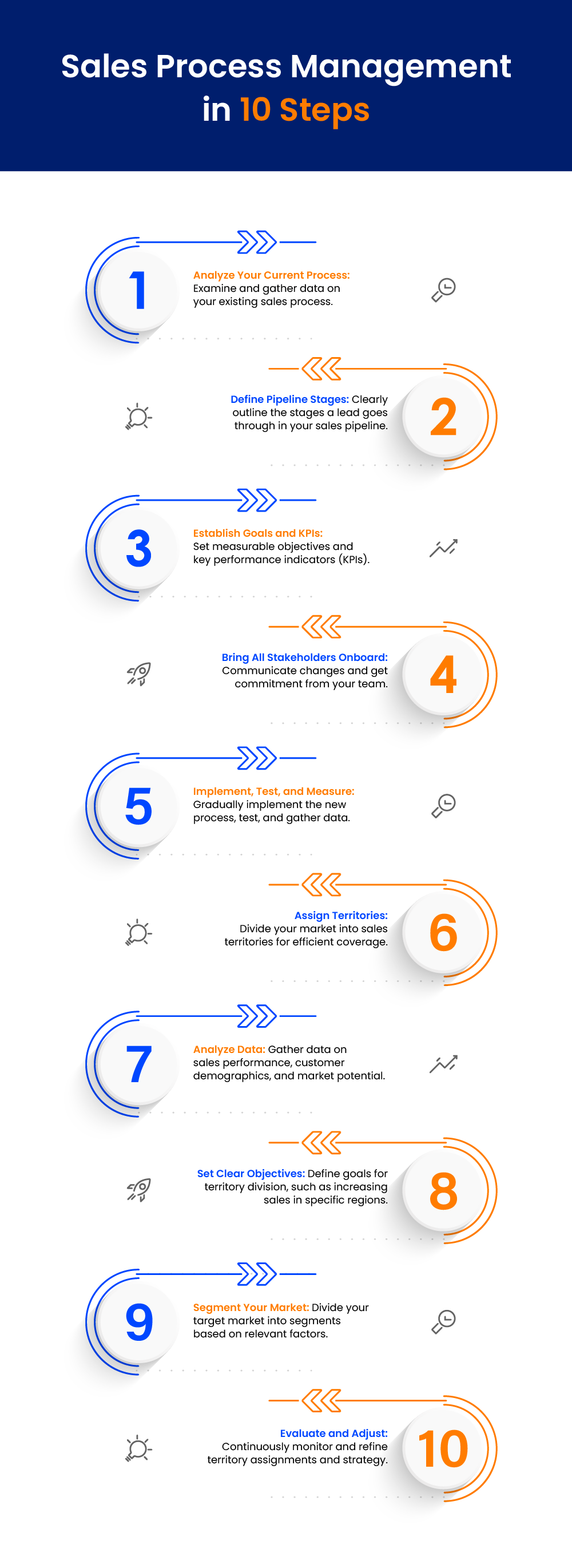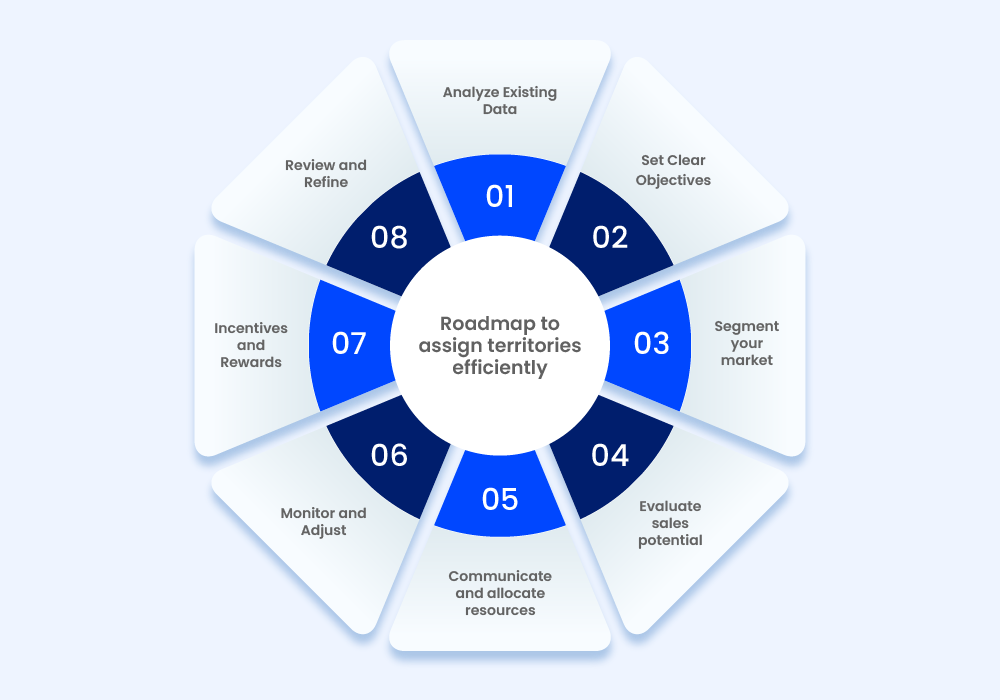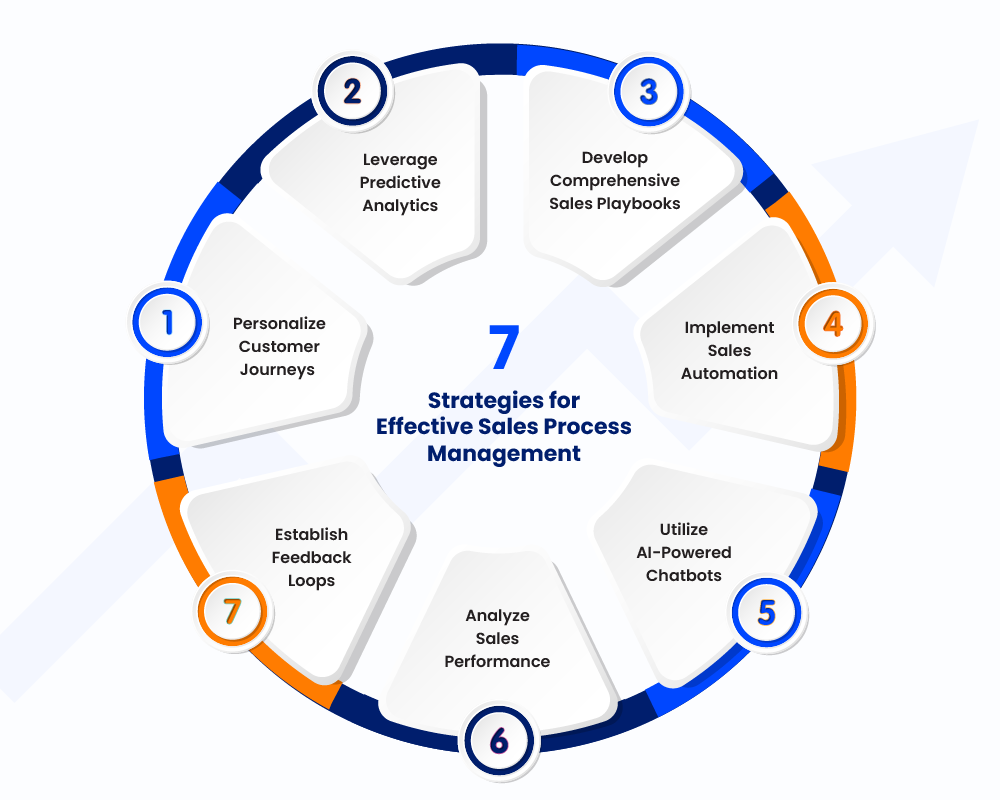In today’s competitive business landscape, companies often grapple with the challenge of inconsistent sales performance.
Fluctuating revenue, missed opportunities, and a lack of clear direction in closing deals lead to missed growth potential.
Sales process management is a critical component of consistent success in sales. Besides adding structure to your sales process, it also provides you with a dependable roadmap for repeatable success.
In this article, you’ll learn what sales process management is all about, why it is worth your time and how you can set up your own sales process management with a stepwise guide, strategies for success and a go to list of all the tools you’ll need.
What is Sales Process Management?
Sales process management is the systematic coordination of your sales process to optimize your sales team’s performance and set them up for success.
Taking a process-oriented approach to sales helps you identify problems early on, set high but realistic sales targets and most importantly equips you to recreate the magic of outstanding sales numbers time and again.
If your business is bringing in any amount of revenue, you simply must have a sales process management system in place. Read on to know why.
The Importance of Sales Process Management
1. Increases Efficiency and Effectiveness
Effective sales process management is like having a well-structured roadmap. It streamlines the entire sales journey, reducing wasted time and effort.
When sales professionals follow a defined process, they can systematically move from one stage to the next, ensuring that no critical steps are overlooked.
This meticulous approach not only saves valuable time but also increases effectiveness. Salespeople can focus on nurturing leads and closing deals rather than getting bogged down in disorganized workflows.
2. Increases Collaboration and Alignment
Sales and marketing departments often work in silos, but a managed sales process fosters collaboration and alignment.
When both teams share a mutual understanding of the sales process, it becomes easier to tailor marketing efforts to specific stages of the customer journey.
As a result, leads generated by marketing are more likely to seamlessly transition into the sales pipeline, creating a smoother and more efficient customer experience.
3. Increases Customer Satisfaction
Customer satisfaction is the ultimate goal of any sales effort. A well-managed sales process allows sales professionals to truly understand their customers’ needs and pain points.
By doing so, they can personalize their interactions and solutions, exceeding customer expectations.
Satisfied customers are not only more likely to make a purchase. They are also more likely to become advocates for the brand.
This leads to positive word-of-mouth and contributes to long-term success.
4. Process-driven Approach Boosts Deal Closure
A structured sales process is designed to guide potential customers through a carefully orchestrated journey.
At each stage, sales professionals can employ strategies and tactics that have proven successful in moving prospects closer to a buying decision.
This approach minimizes guesswork, maximizes the use of effective sales techniques, and significantly increases the likelihood of successfully closing deals.
5. Increases the Likelihood of Team Productivity
In a team environment, a well-defined sales process is similar to a playbook that everyone can follow.
It creates clarity and consistency, ensuring that every team member knows their role and responsibilities at each stage. This reduces confusion, duplication of efforts, and misunderstandings.
When team members are aligned with the sales process, they can collaborate more effectively, delegate tasks efficiently, and specialize in areas where they excel. This, in turn, boosts overall team productivity and performance.
6. Boosts Return on Investment (ROI)
ROI is a crucial metric in sales, and a structured sales process allows for precise measurement and optimization.
By tracking the progress of leads through each stage of the process, sales professionals can identify which strategies are most effective and where improvements are needed.
This data-driven approach ensures that resources are allocated to activities that yield the highest ROI.
In essence, a well-managed sales process is an investment in itself, as it enables sales teams to strategically allocate their time and efforts, resulting in a more significant return on investment over time. If you’re ready to make this investment, take the following steps post-haste.
Steps in Sales Process Management

Step 1: Analyze Current Sales Process
Start by examining every aspect of your current sales process. Identify the different stages a lead goes through, the methods used to attract and convert leads, and the tools and technologies in place.
This step also involves collecting data on how your team currently operates, including tracking conversion rates, sales cycle length, and customer feedback.
Step 2: Define Pipeline Stages
Clearly define the various stages a lead goes through in your sales pipeline.
Common stages include lead generation, lead qualification, opportunity creation, proposal/quote, negotiation, and closing. Having distinct pipeline stages helps in tracking and managing leads efficiently.
Tailor your sales activities to correspond with each pipeline stage.
For instance, early-stage leads may require educational content, while leads in the negotiation stage need personalized proposals.
Ensure your sales team understands which activities are appropriate for each stage and when to advance or disqualify leads.
Step 3: Establish Goals and KPIs
Set concrete and measurable goals that align with your business objectives. These goals could be related to revenue targets, market share, customer acquisition, or any other relevant metrics.
Alongside your goals, define Key Performance Indicators (KPIs) that allow you to track progress.
Step 4: Bring All Stakeholders Onboard
Effective communication is vital at this stage. Engage with your sales team, managers, and any other relevant stakeholders.
Explain the reasons for the changes you are implementing and the expected benefits. Address any concerns and make sure everyone is committed to the new process.
Step 5: Implement Changes, Test and Measure
Start implementing the new process gradually. You don’t want to overwhelm your team. Test out the process as you implement it and gather data to substantiate and measure the effectiveness of your process.
Compare the data to your projections. Make adjustments as needed to optimize performance and bridge any gap between outcomes and expectations.
Step 6: Assign Territories
Divide your market or customer base into territories for your sales reps. This ensures efficient coverage and focus on specific areas or customer segments.
Dividing a sales territory involves careful planning and consideration. Here are the steps to help you with the process:

1. Analyze Existing Data: Start by gathering data on your current sales performance, customer demographics, and market potential. This will provide insights into where your sales are strong and where there is room for growth.
2. Set Clear Objectives: Define your goals for dividing the territory. Are you looking to increase sales in a specific region, improve customer service, or balance the workload among your sales team?
Setting clear goals is the first step to ensure that your territory division strategy aligns with your overall business objectives.
3. Segment Your Market: Divide your target market into segments based on factors like geography, industry, customer type, or product/service needs. This will help you understand the unique characteristics of each segment.
4. Evaluate Sales Potential: Estimate the sales potential for each segment by considering factors such as market size, competition, and historical performance.
This provides valuable insights into where to allocate resources, which segments offer the most growth opportunities, and ensures that your sales strategy is data-driven and focused on high-impact areas.
5. Communicate and Allocate Resources: Ensure that changes are communicated effectively to the sales team, addressing any concerns.
Additionally, provide necessary resources, including marketing materials, leads, and training, to support effective territory coverage.
6. Monitor and Adjust: Continuously monitor the performance of each sales territory. Track sales, customer feedback, and market changes. If necessary, be prepared to adjust territory boundaries or assignments to optimize results.
7. Incentives and Rewards: Implement a system of incentives and rewards to motivate your sales team to achieve their targets and foster healthy competition.
8. Review and Refine: Periodically review your territory division strategy to ensure it aligns with your company’s evolving goals and market conditions. Make adjustments as needed to better align your strategy to the dynamic market.
Keep in mind that this is an ongoing process that requires flexibility and adaptability to changing market dynamics.
Step 7: Give an Effective Pitch
Provide extensive training to your sales team to improve their presentation and negotiation skills.
This step involves:
- Refining communication techniques
- Objection handling
- Product knowledge
Enhancing your team’s sales abilities through regular coaching and maintaining open communication channels can go a long way in helping you realize your sales targets.
Step 8: Forecast Performance
Utilize previous data and current KPIs to create accurate sales forecasts. This forecasting process helps in resource allocation, budgeting, and setting realistic targets for your sales team. Regularly revisit and adjust forecasts based on actual performance.
Step 9: Track Activity Metrics
Continuously monitor relevant activity metrics such as the number of calls made, emails sent, meetings scheduled, and proposals delivered. These metrics provide insights into individual and team productivity. Use them to identify areas for improvement and allocate resources effectively.
Step 10: Develop Essential Sales Skills
Invest in ongoing training and development programs for your sales team. This should cover a wide range of skills, including communication, negotiation, objection handling, and product knowledge. Encourage a culture of continuous improvement and provide opportunities for skill enhancement through workshops, coaching, and online resources.
Now that you know the steps all you need is a set of strategies that will set you up for success.
7 Strategies for Effective Sales Process Management
Optimize your sale process with these strategies:

1. Personalize Customer Journeys
Personalizing customer journeys involves tailoring every aspect of the customer’s experience to their unique needs and preferences.
This includes understanding their pain points, motivations, and behaviours to create a highly engaging and relevant interaction at each touchpoint.
Mapping customer journeys will help you craft individualized sales experiences for each customer and address specific pain points.
Example: Imagine you’re a luxury car dealer. By analysing a customer’s past interactions and preferences, you can personalize their showroom experience. If they’ve shown interest in sports cars, have a sports car ready for a test drive when they arrive.
2. Leverage Predictive Analytics
Predictive analytics leverages historical data, machine learning, and statistical algorithms to forecast future outcomes.
In sales, this means using data to predict which leads are most likely to convert, what products or services they may be interested in, and when they are likely to make a purchase.
Utilizing advanced analytics to forecast customer behavior enables you to proactively engage with potential leads and concentrate your sales efforts on prospects most likely to convert.
Example: A subscription-based streaming service analyzes user viewing habits to predict which shows or movies a user is likely to enjoy. They then send tailored recommendations, increasing user engagement and retention. Think of this the next time Netflix reels you in with “Picks for you”.
3. Develop Comprehensive Sales Playbooks
Sales playbooks are comprehensive guides that outline the entire sales process step by step.
Sales playbooks typically include:
1. Scripts to guide the sales team
You can list the following common scripts in your playbook:
- Elevator pitch script
- Cold calling script
- Discovery call script
- Product demonstration script
- Objection handling script
- Closing script
- Follow-up script
- Referral script
- Voicemail script
- Thank-you script
2. Objection-handling techniques
In order to avoid losing potential customers, be very particular about defining the objection handling approach you want your sales team to take when faced with objections and concerns.
Here are a few standard techniques you can adopt:
- Acknowledge and empathize
- Ask clarifying questions
- Reframe the objection positively
- Provide evidence and benefits
- Offer alternatives
- Suggest a trial close
- Address risk mitigation
- Use comparative analysis
- Leverage social proof
- Consider circling back later
- Maintain professionalism
- Close with confidence
4. Implement Sales Automation
Sales automation involves using technology to automate repetitive and time-consuming tasks in the sales process.
Implementing automation tools to streamline routine tasks like lead nurturing, follow-ups, and data entry, frees up your sales team to focus on building relationships and closing deals.
Automation streamlines workflows, reduces manual errors, and ensures no leads fall through the cracks.
Example: A real estate agency uses automation to send personalized follow-up emails to potential buyers after property viewings. This keeps leads warm and engaged without manual effort.
5. Utilize AI-Powered Chatbots
AI-powered chatbots are virtual assistants that use artificial intelligence to engage with customers in real-time.
They can answer common and frequently asked questions, provide product recommendations, and even handle basic transactions.
You can utilize the 24/7 availability of chatbots to enhance customer support and improve response times.
Integrating AI-driven chatbots into your website and communication channels will enable you to qualify leads, and schedule meetings, ensuring a seamless sales experience.
Example: An online retailer employs a chatbot on their website. When a customer asks about product specifications, the chatbot provides detailed information instantly, mimicking the assistance of a knowledgeable salesperson.
6. Analyze Sales Performance
Sales performance analytics involves tracking and analyzing KPIs to assess the effectiveness of sales strategies and individual sales team members.
It provides insights into areas of improvement, highlights successes, and guides data-driven decision-making.
You can utilize these analytics to identify strengths and weaknesses in your sales process.
Continuously monitoring your sales team’s performance using real-time dashboards will help you provide targeted coaching and training to the team.
Example: If a company using a real-time dashboard to track sales team performance, notices that certain salespeople excel at closing deals with small businesses but struggle with enterprise clients, they can adjust training accordingly.
7. Establish Feedback Loops
Feedback loops establish ongoing communication between sales and marketing teams. They facilitate the sharing of insights, customer feedback, and market trends.
Sales strategies and marketing campaigns create the most impact when there is impeccable co-ordination between the sales and marketing teams. Here are a few pointers to develop effective feedback loops:
- Schedule regular meetings between sales and marketing to promote ongoing communication.
- Align objectives for better synergy.
- Utilize sales input to enhance lead generation strategies.
- Incorporate insights from client interactions into your marketing content.
- Employ end-to-end lead tracking to improve ROI analysis.
- Conduct cross-training to foster mutual understanding.
Example: A health tech company holds regular meetings between the sales and marketing teams. Sales shares insights about the pain points and challenges they hear from patients, which leads to the creation of targeted marketing content and boosts customer acquisition.
The effectiveness of these strategies relies on your ability to adapt them to your specific customer behaviors and dynamic market conditions. This can be achieved through a variety of tools designed to enhance the effectiveness of sales process management.
Tools for Sales Process Management
Here are several tools at your disposal to bolster your sales process management strategy in the face of a volatile, uncertain, complex, and ambiguous (VUCA) market:
1. Customer Relationship Management (CRM)
A CRM system is your trusted ally in managing customer relationships and driving your business forward.
It keeps all your customer information organized, helps you track sales opportunities, automates marketing efforts to engage customers personally, streamlines customer support, and provides valuable data insights for informed decision-making.
With CRM, you can efficiently manage tasks, automate workflows, and generate reports, all designed to enhance your customer interactions and boost your success.
Here are some of the most efficient CRMs:
- LeadSquared: LeadSquared is a dynamic sales execution CRM that offers end-to-end sales solutions for businesses.
This platform utilizes automation and advanced technology to empower sales representatives.
USP: LeadSquared takes the lead with its exceptional sales optimization suite. It seamlessly merges cutting-edge automation, invaluable customer insights, and expert lead nurturing to propel businesses towards unmatched sales success. - Salesforce: Salesforce is a versatile cloud-based CRM platform that helps businesses manage various aspects of their customer interactions. It offers a range of tools and features for sales, marketing, and customer support. With Salesforce, companies can streamline processes, gain insights from customer data, and improve collaboration among teams.
USP: Offers significant versatility, scalability, and a vast ecosystem of integrated applications for businesses of all sizes. - Zoho CRM: Zoho is a cloud-based software suite that offers a range of business applications to support various aspects of company operations. It is designed to enhance business efficiency and productivity by offering accessible and integrated software solutions for organizations of all sizes.
USP: Provides an affordable and user-friendly suite of integrated applications that prioritize data security.
2. Marketing Automation Tools
Marketing automation tools are designed to simplify and enhance your marketing efforts. They help you streamline tasks like email marketing, lead nurturing, and social media management. With these tools, you can efficiently engage your audience, track customer behavior, and optimize your marketing strategies for better results.
- HubSpot Marketing Hub: HubSpot Marketing Hub offers you an all-in-one marketing automation platform, empowering you with robust features for lead generation, email marketing, social media management, and analytics. Its USP lies in its comprehensive solution for marketers, simplifying your marketing efforts.
- Mailchimp: Mailchimp is your go-to choice if you’re looking for an email marketing tool with a user-friendly interface. Its extensive email marketing capabilities make it easy to create and automate email campaigns, making it a reliable marketing automation tool.
- Marketo: Marketo is a robust marketing automation platform known for its advanced lead management and engagement features. It empowers businesses to attract, nurture, and convert leads effectively. Marketo excels in lead scoring, campaign management, and analytics, allowing marketers to optimize their marketing efforts.
3. Performance Tracking Tools
Performance tracking tools are your key to understanding how well your online presence is doing. They provide insights into website and app performance, user behavior, and campaign effectiveness. By using these tools, you can make data-driven decisions and continuously improve your online strategies.
- Google Analytics: Google Analytics offers you comprehensive web and app analytics, allowing you to track user behavior, measure website performance, and make data-driven decisions – all for free. Its USP lies in providing valuable insights for your data-driven decision-making.
- Adobe Analytics: Adobe Analytics empowers you with deep insights and real-time tracking capabilities, helping you understand customer journeys, optimize digital experiences, and make informed marketing decisions. Its USP is its ability to provide in-depth insights for your online strategies.
- SEMrush: SEMrush is your solution for competitive intelligence and SEO analytics. It lets you track keyword rankings, monitor competitors, and optimize your online presence effectively. Its USP lies in helping you stay ahead in the competitive digital landscape.
4. Workflow Automation Tools
Workflow automation tools empower you to automate repetitive tasks and processes within your organization.
They simplify work management by creating efficient workflows, ensuring tasks are completed on time, and enhancing collaboration among team members.
These tools help you work smarter, not harder.
- Zapier: Zapier excels in connecting various web applications and automating workflows, enabling you to create custom integrations between different tools without any coding knowledge. Its USP is its versatility in automating your tasks and processes.
- ClickUp: ClickUp is a powerful automation tool that simplifies tasks, project management workflow, and collaboration.
- Monday.com: Monday.com offers you versatile work management solutions with customizable workflows. It’s suitable for teams across different industries, helping you streamline processes efficiently. Its USP is its adaptability to your specific needs.
5. Pipeline management tools
Pipeline management tools are your go-to solution for organizing and tracking your sales processes. They assist you in managing leads, opportunities, and customer relationships. By using these tools, you can streamline your sales pipeline, prioritize leads, and boost your sales team’s efficiency.
- Microsoft Dynamics 365: Microsoft Dynamics 365 is a robust pipeline management tool, offering businesses a comprehensive solution to track and optimize their sales processes. It provides structured lead management, opportunity tracking, and sales forecasting, allowing organizations to efficiently capture, prioritize, and convert leads into customers.
- Pipedrive: Pipedrive is designed with salespeople in mind. It offers a user-friendly interface and sales-centric features to help your teams manage pipelines, track deals, and close sales efficiently. Its USP is its focus on sales excellence.
- Freshsales: Freshsales combines AI-driven capabilities with an intuitive interface, allowing your business to manage leads, automate tasks, and gain insights to accelerate sales conversions. Its USP is its blend of AI and ease of use.
6. Team Management Tools
Team management tools are designed to facilitate collaboration and productivity within your teams. They offer features like task assignment, project tracking, and real-time communication. With these tools, you can keep everyone on the same page, assign responsibilities, and ensure projects are completed smoothly.
- Asana: Asana is your versatile team management and project tracking tool. With features for task assignments, project timelines, and collaboration, it helps your teams stay organized and productive. Its USP is its flexibility in managing tasks and projects.
- Toggl Plan: Toggl Plan simplifies your team management by providing visual project timelines, task assignments, and team workload tracking. It’s ideal for small to medium-sized teams like yours, helping you manage your projects efficiently.
- Wrike: Wrike offers a powerful team management platform with customizable workflows, task automation, and real-time collaboration. It’s suitable for complex projects and larger teams, making it a robust solution for businesses like yours. Its USP is its adaptability to larger and more complex projects.
Wondering how all of this comes together?
While utilizing LeadSquared’s integrated platform, you effortlessly input and track leads and their interactions.
As leads advance, you can use the integrated email marketing tools for personalized follow-ups.
Additionally, you can measure the success of your campaigns with precision using LeadSquared’s built-in analytics.
You can also access sales enablement features, ensuring your team has the latest product info and sales materials.
These seamlessly integrated tools streamline your sales process, enhancing efficiency for engaging with leads and customers.
Conclusion
In conclusion, effective sales process management is the cornerstone of sustainable business growth.
By implementing clear strategies, optimizing workflows, and fostering a customer-centric approach, organizations can drive revenue, enhance customer satisfaction, and stay ahead in today’s competitive landscape.
Take the first step towards optimizing your sales process with LeadSquared and receive solutions tailored to meet your unique needs.
FAQs
The primary goal of sales process management is to optimize the journey from prospecting to closing deals, ultimately increasing revenue and customer satisfaction.
A well-defined sales process leads to better forecasting, shorter sales cycles, and improved conversion rates, which directly contribute to increased sales and profitability.
Absolutely, sales process management is valuable for businesses of all sizes. It helps small businesses establish consistency, scalability, and competitiveness in their sales efforts.










